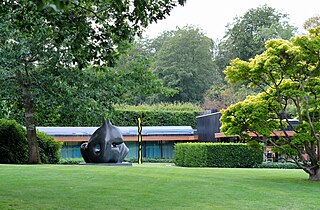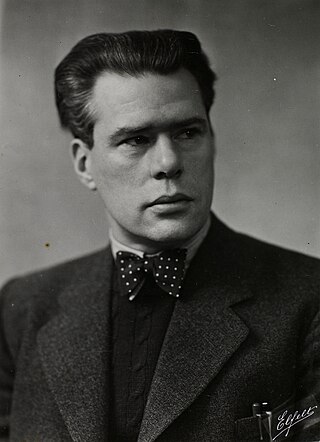Related Research Articles

The Louisiana Museum of Modern Art, also known as just Louisiana is an art museum located on the shore of the Øresund Sound in Humlebæk, 35 km (22 mi) north of Copenhagen, Denmark. It is the most visited art museum in Denmark, and has an extensive permanent collection of modern and contemporary art, dating from World War II to the present day; in addition, it has a comprehensive programme of special exhibitions. The museum is also acknowledged as a milestone in modern Danish architecture, and is noted for its synthesis of art, architecture, and landscape, such as was showcased in an installation entitled "Riverbed" shown in 2014–2015. It has been called a "Danish beacon in the international art world." The museum occasionally also stages exhibitions of work by the great impressionists and expressionists, such as Claude Monet, who was the focus of a major exhibition in 1994. It has between 600,000–700,000 visitors per year, 17–33% of whom reside in nearby Sweden.

Denmark competed at the 1972 Summer Olympics in Munich, West Germany. 126 competitors, 114 men and 12 women, took part in 74 events in 17 sports.

Assistens Cemetery in Copenhagen, Denmark, is the burial site of many Danish notables as well as an important greenspace in the Nørrebro district. Inaugurated in 1760, it was originally a burial site for the poor laid out to relieve the crowded graveyards inside the walled city, but during the Golden Age in the first half of the 19th century it became fashionable and many leading figures of the epoch, such as Hans Christian Andersen, Søren Kierkegaard, Christoffer Wilhelm Eckersberg, and Christen Købke are all buried here.

Denmark competed at the 1984 Summer Olympics in Los Angeles, United States. 60 competitors, 49 men and 11 women, took part in 33 events in 11 sports.

Denmark competed at the 1960 Summer Olympics in Rome, Italy. 100 competitors, 88 men and 12 women, took part in 46 events in 15 sports. Cyclist Knud Enemark Jensen died during the team time trial.

Denmark competed at the 1952 Summer Olympics in Helsinki, Finland. 129 competitors, 115 men and 14 women, took part in 73 events in 15 sports.

Denmark competed at the 1936 Summer Olympics in Berlin, Germany. 121 competitors, 105 men and 16 women, took part in 71 events in 14 sports.

The former Diocese of Odense was a Roman Catholic diocese in Denmark which included the islands of Funen, Langeland, Tåsinge, Lolland, Falster, Als, and Ærø. Its episcopal see was located in Odense at St. Canute's Cathedral.
The 1964 Danish 1st Division was the 37th season of Denmark's top-flight association football division since the establishment of Danmarksturneringen's nation-wide league structure in 1927, and the 51st edition of the overall Danish national football championship since its inception in 1912. Governed by the Danish FA, the season was launched on 26 March 1964 with a clash between last season's third-placed B 1903 and Østerbro-based and local rivals B.93 with the last round of six matches concluding on 15 November 1964. Esbjerg fB were the defending league champions, having won their third consecutive league title last season, while BK Frem and B.93 entered as promoted teams from the 1963 Danish 2nd Division. Fixtures for the 1964 season were announced by the Danish FA's tournament committee on 6 January 1964, featuring a nine weeks long summer break.
Fængslende feriedage is a 1978 Danish comedy family film directed by Finn Henriksen and starring Jørgen Ryg. This was Dirch Passer's final film.

Mogens Koch was a Danish architect and furniture designer and, from 1950 to 1968, a professor at the Royal Danish Academy of Fine Arts.

Danish Academy is an independent organisation founded in 1960 by a circle of Danish intellectuals "to promote Danish esprit and language, especially within the field of literature". It has up to 20 members, currently 18, and is based at Rungstedlund, the former home of author Karen Blixen who was one of the original members. The Academy runs a number of annual literary prizes including most notably its Grand Prize.
The Grand Prize of the Danish Academy, founded in 1961, is the most notable of Denmark's literature prizes and awards. It is awarded by the Danish Academy. Until 1982, it was handed yearly, but since then it has been given every second year. The first years the prize was 50.000 DKK. In 1982 the Cultural Ministry of Denmark increased the prize to 100.000 DKK. From 1992 to 1997 it was 200.000 DKK, in 1998 it was 250.000 DKK and since 2000 it has been 300.000 DKK. The prize is a recognition of a writers work as a whole and not only for one book.
The Danish Critics Prize for Literature is an annual Danish literature award. It was established in 1957 by the Danish Publishers Association. Since 1971 the award has been made by the Danish Literature Critics Association after a vote by members. The award currently carries a prize of DKK 30,000. The Association also awards the Georg Brandes-Prize.

The L-groups was a resistance group tasked with assassination of Danish collaborators and German forces occupying Denmark during the Second World War. The precursor to the group was established in 1940, but it was most active from 1944 to the end of the war. The group carried out at least 18 assassination operations and killed between 20 and 30 people. In 1945 the group was hard hit by arrests and killings of its members and further suffered a very high death-rate in the years immediately after the war with suicides and accidents killing a number of members. The group had strong ties to the Danish police, with 5 of its members being police officers.
The Weekendavisen Book Award is an annual literary award presented by the Danish newspaper Weekendavisen. The nominees are selected in December by Weekendavisen's corps of literary critics, and the final winner is selected by the readers. The ceremony takes place in January the following year.
References
- ↑ John L. Loeb Jnr, The Ambassador John L. Loeb Jnr Danish Art Collection, John L. Loeb Jnr, New York, 2005, Appendix A: An Overview of Danish Royal and Secular Art Collections, Exhibitions, Museums and Art Associations in Denmark Retrieved December 2008Archived 2011-07-13 at the Wayback Machine
- 1 2 3 "Tildelinger af medaljer". Royal Danish Academy of Fine Arts. Archived from the original on 2 February 2015. Retrieved 2 November 2014.
- 1 2 3 Jensen Silver, The Georg Jensen Designers, http://www.jensensilver.com/news-info/designers.html (retrieved December 2008)
- ↑ "Gunnar Westman", Kunstindeks Danmark & Weilbachs Kunstnerleksikon. Retrieved 25 May 2012.
- ↑ "Willy Ørskov", Kunstindeks Danmark & Weilbachs kunstnerleksikon. Retrieved 7 June 2012.
- ↑ "Akademiraadet | Motivering". www.akademiraadet.dk. Archived from the original on 2021-05-18. Retrieved 2016-03-07.
- ↑ "Akademiraadet | Motivering". www.akademiraadet.dk. Archived from the original on 2021-06-16. Retrieved 2016-03-07.
- ↑ "Akademiraadet | Motivering". www.akademiraadet.dk. Archived from the original on 2021-05-10. Retrieved 2016-03-07.
- ↑ "Akademiraadet | Motivering". www.akademiraadet.dk. Archived from the original on 2021-06-16. Retrieved 2016-03-07.
- ↑ "Akademiraadet | Motivering". www.akademiraadet.dk. Archived from the original on 2021-05-18. Retrieved 2016-03-07.
- ↑ "Akademiraadet | Motivering". www.akademiraadet.dk. Archived from the original on 2017-10-23. Retrieved 2016-03-07.
- ↑ "Akademiraadet | Motivering". March 4, 2016. Archived from the original on 2016-03-04.
- ↑ "Akademiraadet | Motivering". www.akademiraadet.dk. Archived from the original on 2017-10-23. Retrieved 2016-03-07.
- ↑ "Akademiraadet | Motivering". www.akademiraadet.dk. Archived from the original on 2018-07-02. Retrieved 2016-03-07.
- ↑ "Akademiraadet | Motivering". www.akademiraadet.dk. Archived from the original on 2021-06-16. Retrieved 2016-03-07.
- ↑ "Akademiraadet | Motivering". March 7, 2016. Archived from the original on 2016-03-07.
- ↑ "Akademiraadet | Motivering". March 7, 2016. Archived from the original on 2016-03-07.
- 1 2 "Akademiraadet | Motivering". March 27, 2016. Archived from the original on 2016-03-27.
- ↑ "Akademiraadet | Motivering". www.akademiraadet.dk. Archived from the original on 2021-05-18. Retrieved 2016-03-07.
- ↑ "Akademiraadet | Motivering". www.akademiraadet.dk. Archived from the original on 2021-05-10. Retrieved 2016-03-07.
- ↑ "Akademiraadet | Motivering". www.akademiraadet.dk. Archived from the original on 2021-05-18. Retrieved 2016-03-07.
- ↑ "Akademiraadet | Motivering". www.akademiraadet.dk. Archived from the original on 2021-05-18. Retrieved 2016-03-07.
- ↑ "Akademiraadet | Motivering". www.akademiraadet.dk. Archived from the original on 2021-06-16. Retrieved 2016-03-07.
- ↑ "Akademiraadet | Motivering". www.akademiraadet.dk. Archived from the original on 2021-06-16. Retrieved 2016-03-07.
- ↑ "Akademiraadet | Motivering". www.akademiraadet.dk. Archived from the original on 2021-06-16. Retrieved 2016-03-07.
- ↑ "Akademiraadet | Motivering". www.akademiraadet.dk. Archived from the original on 2017-10-23. Retrieved 2016-03-07.
- ↑ "Akademiraadet | Motivering". www.akademiraadet.dk. Archived from the original on 2021-05-18. Retrieved 2016-03-07.
- ↑ "Akademiraadet | Motivering". www.akademiraadet.dk. Archived from the original on 2021-05-18. Retrieved 2016-03-07.
- ↑ "Akademiraadet | Motivering". www.akademiraadet.dk. Archived from the original on 2021-05-18. Retrieved 2016-03-07.
- ↑ "Akademiraadet | Motivering". www.akademiraadet.dk. Archived from the original on 2021-05-18. Retrieved 2016-03-07.
- ↑ "Akademiraadet | Motivering". www.akademiraadet.dk. Archived from the original on 2021-05-18. Retrieved 2016-03-07.
- ↑ "Akademiraadet | Motivering". www.akademiraadet.dk. Archived from the original on 2021-06-16. Retrieved 2016-03-07.
- ↑ "Akademiraadet | Motivering". www.akademiraadet.dk. Archived from the original on 2018-06-29. Retrieved 2016-03-07.
- ↑ "Akademiraadet | Motivering". www.akademiraadet.dk. Archived from the original on 2021-06-16. Retrieved 2016-03-07.
- ↑ "Akademiraadet | Motivering". www.akademiraadet.dk. Archived from the original on 2021-05-10. Retrieved 2016-03-07.
- ↑ "Akademiraadet | Motivering". www.akademiraadet.dk. Archived from the original on 2021-05-18. Retrieved 2016-03-22.
- ↑ "Akademiraadet | Motivering". www.akademiraadet.dk. Archived from the original on 2021-06-16. Retrieved 2016-03-22.
- ↑ "Akademiraadet | Motivering". www.akademiraadet.dk. Archived from the original on 2021-06-16. Retrieved 2016-03-22.
- ↑ 2017 PressemeddelseAkademiraadet Archived 2018-02-26 at the Wayback Machine